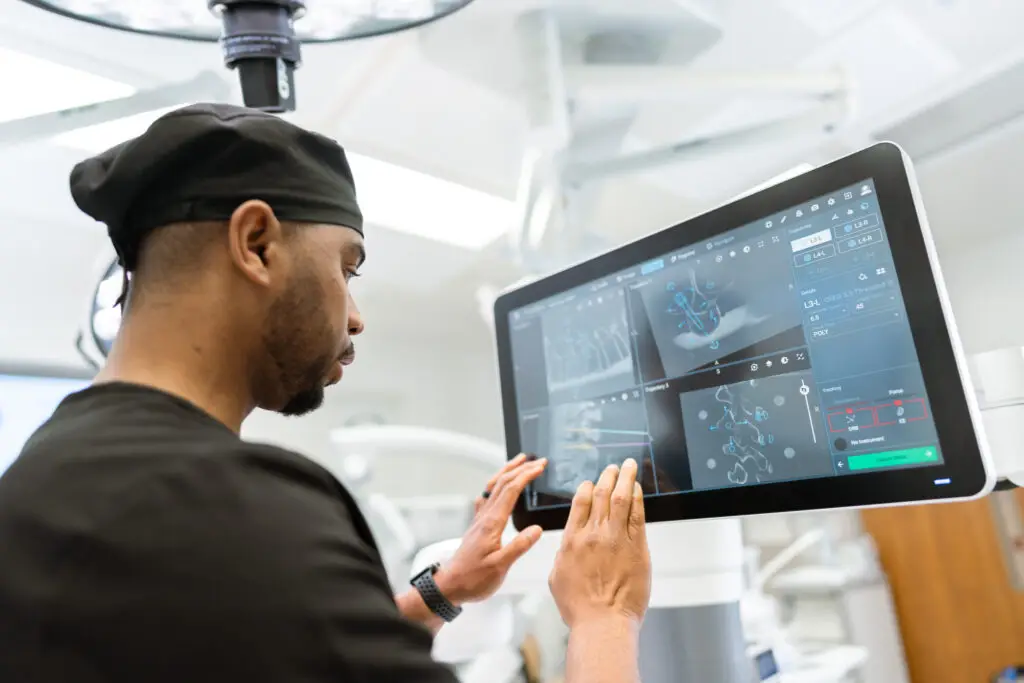The numbers associated with degenerative disc disease are painful to consider. Several reputable medical sources note that about 20 percent of all U.S. adults have some amount of disc degeneration by age 65, and this increases to 35 percent by age 80. It is one of the primary causes of back pain.
Demographic research suggests two factors that partially explain the growth of this condition: About one-third of the population is 65 or older and obesity continues to be a chronic condition among this group. These discs, which serve as the natural “cushions” between vertebrae of the spine, wear out with age and use.
When this occurs, the spine experts at Texas Back Institute are often consulted to treat patients with degenerative disc disease (DDD).
Over the course of more than 45 years, the world class spine experts at the Texas Back Institute have diagnosed and treated thousands of patients who are experiencing the pain of DDD. If you suspect your back pain might be due to this condition, click here to schedule an appointment today.
An Expert Explains DDD

Dr. Uche Davidson a spine surgeon at Texas Back Institute, has treated hundreds of patients whose quality of life has been severely affected by disc degeneration.
“The spine is the central supporting structure of the torso,” he notes. “It routes and protects the spinal cord while providing flexibility and shock absorption. When the wear and tear of age, obesity or other factors cause degeneration of the soft tissues found between the vertebrae – the discs – this can affect the range of motion, loading patterns, and tolerance to minor traumatic events.”
DDD is also known as Spondylosis or spinal osteoarthritis, and it is the progressive deterioration of the discs between the vertebral bodies.
Dr. Davidson explains, “Spondylosis is a general term used to describe the degenerative condition of one or more of the many structures that make up the spine. The discs, joints, and ligaments of the spine are generally involved.
“Spondylosis occurs with aging, as the shock-absorbing cushions termed intervertebral discs lose fluid resulting in decreased flexibility of the spine, bulging, thinning, and lesser cushioning ability of the discs. Aside from the normal wear and tear as the individual ages, degenerative disc disease can also occur due to injury as a result of external trauma or repetitive stress on the vertebra.
“Other common factors that can contribute to the advancement of disc degeneration include obesity, smoking, and genetic factors.”
Symptoms of Degenerative Disc Disease
“Not everyone with DDD will have symptoms (usually pain) as a result of spondylosis, “Dr. Davidson points out. “If severe, spondylosis may cause pressure on nerve roots with subsequent pain or tingling in the arms or legs.
“The most common clinical manifestation of DDD is lower back pain that may or may not radiate to the posterior buttocks, thigh, ankle and can sometime trave down to the feet. Some individuals who experience pain from Spondylosis describe lower back stiffness or rigidity in the morning.”
Treatments Vary with Severity
In the case of treating DDD, most patients require only non-surgical treatments. The spine experts at Texas Back Institute only recommend surgery as a final option.
Dr. Davidson adds, “Non-surgical treatments for spondylosis include some combination of anti-inflammatory medications like NSAIDs, chiropractic care, physical therapy, activity modification and pain management medications. If pain is arising from nerve root irritation, an epidural steroid injection may be considered.
“If the pain continues or there is evidence of a severely compressed nerve, surgery may be considered. Surgery for spondylosis is aimed at alleviating the pain by eliminating what is causing pain – a disc bulge, overgrown spinal joints, soft tissue overgrowth or abnormal motion as known as a slipped vertebra.
Spondylosis and disc degeneration causing functionally disabling pain that fails to improve with conservative treatment may be treated with spine surgery.
“If there is a ‘slip’ and it is severe, or there are neurologic changes, the slipping vertebrae might be surgically fused to the vertebra below it to eliminate the abnormal motion that leads to severe nerve compression. Surgery may also include decompression, which means removing the tissue that is pressing on nerves. Decompression surgery could be done through ultra minimally invasive techniques. Additionally, patients could be a candidate for disc replacement which is a motion preservation surgery.
“Every case is different,” Dr. Davidson concluded. “It is important to discuss treatment options with your doctor in deciding which treatment, if any, may be best for you.”
If back pain is reducing your quality of life, it may be time to consult a specialist. The physicians at Texas Back Institute are here to help. Click here to schedule an appointment and feel like yourself again!



I live in Las Vegas and I have not had any success in reducing my lower back pain. I have been diagnosed w Degenerative Disk Disease. I am now trying laser treatment but am not optimistic.